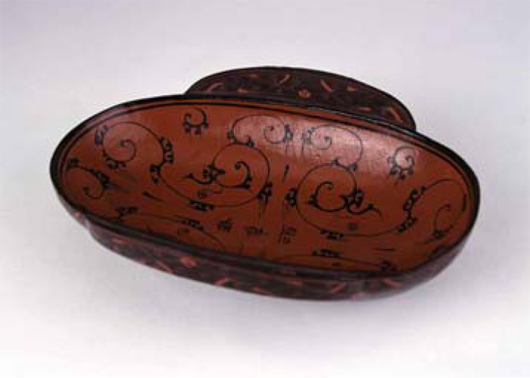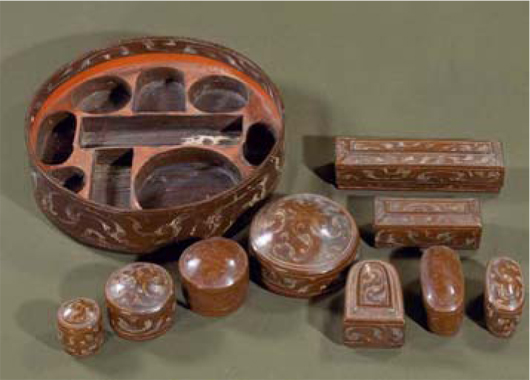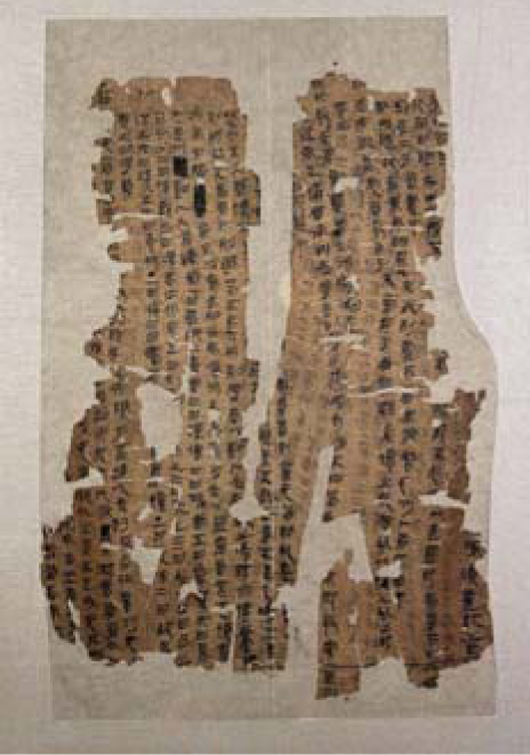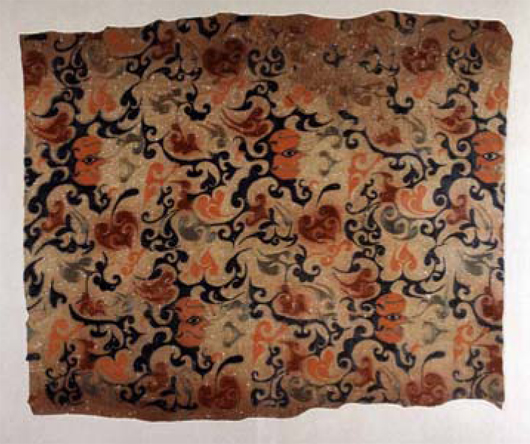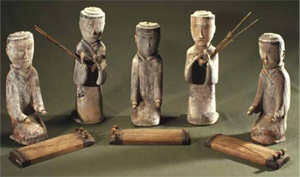
SANTA BARBARA, Calif. – More than 2,000 years ago, a Chinese marquis and his family began their plans for the afterlife with three lavish tombs in Hunan Province, which were excavated in the 1970s. For the first time in the United States, their extraordinary existence will come to life in the exhibition Noble Tombs at Mawangdui: Art and Life in the Changsha Kingdom, China (3rd Century BCE – 1st Century CE).
Nearly 70 treasures including lacquer ware, wood carvings, jade ornaments, bronze sculptures, seals, and silk costumes and textiles from the Hunan Provincial Museum will be on view at the Santa Barbara Museum of Art from Sept. 19 through Dec. 13, after an exhibition at the China Institute in New York City earlier this year.
The excavation at Mawangdui in southeastern China is considered one of the major archaeological discoveries of the 20th century. The tombs containing the remains and possessions of the Marquis of Dai and his wife and son were found between 1972 and 1974 in the archaeological site of Mawangdui, which is located in a suburb of the modern city of Changsha, Hunan Province. More than 3,000 objects from the Western Han dynasty (206 B.C.-A.D. 25) were found in extraordinary condition representing the highest levels of workmanship. The tomb that housed the wares most represented in the exhibition, also held the remarkably well-preserved body of the noblewoman of the family, known affectionately as “Lady Dai.”
“People during the Han dynasty regarded death as birth and longed for immortality,” said Willow Hai Chang, director of the China Institute Gallery. “To prepare for the afterlife, they constructed their tombs to be eternal residences. As a result of this landmark excavation, we now have a rare window into the fascinating Han civilization through these remarkable objects of the highest artistry.”
The extraordinary significance of this assemblage is not only apparent in the variety and quality of objects, but also the period and place from whence these artifacts originated. The Changsha Kingdom was heir to the Chu culture in southeastern China. It played a significant role in the cultural formation of the Han dynasty (202 B.C.-A.D. 220), a defining period in Chinese history that shaped the artistic, intellectual, political, religious and social foundations of Chinese civilization. The objects preserved in the Mawangdui tombs give a visual dimension to early Han Dynasty beliefs, design and technology, while the body of material culture challenges us to re-evaluate our current understanding of early China.
Works in the exhibition showcase those items that were felt to have great meaning to the owner, thereby deeming them necessary in life after death. Many of the objects preserved delicate or perishable materials, such as food, drink and cosmetics, mostly fashioned with wood, silk and paper. Some specific highlights include a two-tiered cosmetic box containing nine small boxes, thought to have belonged to Lady Dai. The outer surface of the box is coated with black lacquer and then affixed with patterned gold foil, and the interior coated with vermilion lacquer. The nine small boxes in the lower tier contained items that could have been found on many women’s dressing tables at the time: cosmetics, rouge, silk powder pads, combs and a needle case.
Of course, what would a journey be to the afterlife without the joy of music. Five charming wooden figurines of musicians, which seem to form a small family band, are included in the exhibition, indicating the importance of song and dance to the tomb occupant. The figures are painted in black and vermilion to depict their faces and colorful gowns.
The tombs at Mawangdui also contained a stunning amount of information in the form of books and tablets on health, well-being and longevity. These findings are particularly intriguing as they represent some of the earliest examples of a cohesive writing style including the Chinese characters that are utilized today. One inscribed tablet refers to dried soybean seeds that have germinated and were used in the treatment of headache, paralysis, asthma and other health problems. Another book, entitled Prescriptions for Maintaining Health, was written on silk and contains 32 different medical prescriptions.
The exhibition also features one remarkably preserved silk robe and textile fragments two of which are the world’s earliest known examples of printed and painted design on gauze weave. From these superb examples, silk was widely used among nobilities in early Han dynasty. The technology of silk production and textile making reached an unprecedented height that is rarely surpassed today. Hunan embroidery remains one of the four celebrated styles of embroidery in China.
Noble Tombs at Mawangdui: Art and Life in the Changsha Kingdom, China is organized by the China Institute Gallery in collaboration with the Hunan Provincial Museum, and is curated by Chen Jianming, director of the Hunan Provincial Museum, who also edited the catalog. A fully illustrated, bilingual catalog accompanies the exhibition.
Free Lecture Series
The Mawangdui finds have spurred enormous scholarly interest. In this multidisciplinary
lecture series, specialists in art, archaeology, history and literature will discuss the noble tombs and Chu culture of the Changsha Kingdom, underscoring the significance of Mawangdui by drawing attention to the Yangtze River region as a conduit for cultural exchange and innovation during the early Han dynasty.
All lectures are free and will be held in the Mary Craig Auditorium. Seating is limited.
Mawangdui and Its Place in the History of Chinese Funerary Customs
Sunday, Sept. 27, 2:30-3:30 p.m.
The rich finds from the Mawangdui tombs document local religious conceptions concerning death and the afterlife during the early Han period. Archaeological research over the past half-century allows us to trace the origins of this belief system back to earlier epochs and places. This lecture will show how various customs attested at Mawangdui had developed previously, and it will draw contrasts to contemporaneous practices in other parts of China. Lecturer: Lothar von Falkenhausen, professor of Chinese Art History and Archaeology at UCLA and director pro tem of the Cotsen Institute of Archaeology at UCLA.
Roaming in the Celestial Realm: Immortality and the Imagination in Han Dynasty China
Sunday, Oct. 4, 2:30-3:30 p.m.
Among the motifs decorating Han dynasty mortuary objects, including those found in the tomb of the noblewoman at Mawangdui, are clouds and creatures representing an “other world” through which the soul journeys after death. These motifs are especially prevalent in tombs of the first half of the Han dynasty and are clearly relatable to the growth of what has been labeled the immortality cult-a melding of longstanding religious notions of what happens after death with a popular fascination with the idea of attaining everlasting life. Expansion of the Han Empire during this time further fueled the imagination of what lay beyond. This lecture will survey and contextualize many of the exquisite objects found in Western Han tombs, including the famous painted banner and coffins of Mawangdui, to demonstrate the creative burst of artistic imagination that accompanied the speculative flights of Han dynasty belief. Lecturer: Peter Sturman, professor of Chinese Painting and Calligraphy, Department of the History of Art and Architecture at UCSB.
Rethinking Early China in Light of the Mawangdui Finds
Sunday, Oct.18, 2:30-3:30 p.m.
Many of the archaeological discoveries at Mawangdui have great artistic merit and aesthetic appeal. Beyond these qualities, however, the Mawangdui finds suggest that certain of our assumptions about early China, until now based on Confucian canonical texts, need serious reconsideration. As such the archaeological finds at Mawangdui are a powerful reminder of the narrowness of the elite textual tradition and the important place that should be given to evidence of material culture in our reconstructions of ancient civilizations. This talk examines the ways that the Mawangdui finds challenge us to rethink our understanding of early China. Lecturer: Ron Egan, professor of Chinese Literature and Aesthetics, Department of East Asian Languages and Cultural Studies at UCSB.
Artisans of Ancient China
Sunday, Nov. 15, 2:30-3:30 p.m.
In viewing objects like those found at Mawangdui, their anonymous creators generally remain in obscurity. This lecture focuses on these oft forgotten individuals, the men and women who crafted objects in private workshops and government factories during the Han Dynasty. Among the topics to be discussed are artisan training, societal perception, tools and techniques, and marketing. Special attention will be given to lacquer workshops and artisans, like those that produced the beautiful pieces in the current exhibition. Lecturer: Anthony Barbieri-Low, associate professor of Ancient China, Chinese Archaeology, and Epigraphy, Department of History at UCSB.
The Santa Barbara Museum of Art is a privately funded, not-for-profit institution that presents internationally recognized collections and exhibitions and a broad array of cultural and educational activities as well as travel opportunities around the world.
Santa Barbara Museum of Art, 1130 State St., Santa Barbara, Calif., is open Tuesday – Sunday 11 a.m. to 5 p.m.; closed Monday. Phone 805-963-4364 or visit the Web site www.sbma.net.
ADDITIONAL IMAGES OF NOTE
